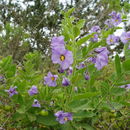Description
provided by Phytokeys (archived)
Shrubs or small trees 1–3(-3) m tall, often spreading to 2 m diameter (“weakly erect” fide Thorne & Everett 34931). Stems densely pubescent with transparent simple uniseriate trichomes of varying lengths, the longest ca. 3 mm long, with weak tangled tips, usually glandular with a single-celled gland, drying brownish tan (“tawny”); new growth densely pubescent with similar simple uniseriate glandular trichomes, these glistening and glandular. Bark of older stems brownish green, somewhat glabrescent. Sympodial units plurifoliate. Leaves simple or very occasionally with two small lobes at the base, highly variable in size along a single stem, 3–11(-14) cm long, 1.6–5.5(-9) cm wide, elliptic to obovate, both surfaces densely and evenly pubescent with long simple uniseriate trichomes to 3 mm long, these usually glandular with single-celled glands on tips, the pubescence slightly denser along the veins; primary veins 7–9 pairs, drying paler than the lamina; base truncate or acute (seemingly depending on age of leaf); margins entire or slightly undulate, occasionally lobed with 1 or 2 small lobes near the base, the lobes very small; apex acute; petioles 1–2.5(-4) cm long, pubescent with simple uniseriate trichomes like the leaves and stems, never twining. Inflorescences terminal or lateral, (2-)4–10 cm long, usually branched once, occasionally more often, with 20–30 flowers, only a few open at a time, densely pubescent with transparent simple uniseriate glandular trichomes to 2.5 mm long like those of the stems; peduncle (1-)2–5 cm, flowers only borne above the lowest branching point; pedicels 1.5–2 cm long, ca. 0.5 mm in diameter at the base, ca. 1 mm in diameter at the apex, slender, spreading, densely pubescent with transparent simple trichomes like those of the inflorescence axis, articulated at the base and inserted into a small sleeve 1–1.5 mm long, this obscured by the dense pubescence. Buds ellipsoid to obovoid, included in the calyx tube until just before anthesis. Flowers all perfect. Calyx tube 3–3.5 mm long, broadly cup-shaped, the lobes 3–3.5 mm long, deltate, densely pubescent like the pedicels and inflorescence axis. Corolla 3–4.5 cm in diameter, violet to purple with or without green spots at the base of the lobes, the spots usually small and not confluent, rotate, lobed <1/4 of the way to the base, the lobes 0.3–0.5 mm long, 1–1.5 mm wide, planar or slightly cupped at anthesis, apiculate, the apiculae ca. 2 mm long, the abaxial surface densely pubescent with tangled simple uniseriate eglandular trichomes along the lobe midvein and laterally, the sinuses and adaxial surfaces glabrous. Filament tube minute, the free portion of the filaments 2–3 mm, pubescent with weak simple uniseriate trichomes near the base; anthers 4.5–5 mm long, 2–2.5 mm wide, ellipsoid, loosely connivent or spreading and not touching, poricidal at the tips, the pores lengthening to slits with age. Ovary glabrous; style 10–13 mm long, minutely papillate with slender glandular papillae or trichomes in the basal half; stigma capitate, the surface minutely papillate. Fruit a globose berry, 3–4 cm in diameter, glabrous, the pericarp shiny, green, turning yellow then black when ripe; fruiting pedicels 1.5–2 cm long, ca. 1.5 mm in diameter at the base, hanging from the weight of the berry. Seeds more than 100 per berry, 1.5–2 mm long, 1–1.5 mm wide, plumpish flattened reniform, reddish brown, the surfaces minutely pitted, the cells sinuate, when mature the seed appearing silky hairy with hair-like projections of the lateral cell walls, these ca. 0.2 mm long over the entire seed surface. Chromosome number: not known.
- bibliographic citation
- Knapp S (2013) A revision of the Dulcamaroid Clade of Solanum L. (Solanaceae) PhytoKeys 22: 1–432
- author
- Sandra Knapp
Distribution
provided by Phytokeys (archived)
(Figure 100, inset). Endemic to Santa Catalina Island (Los Angeles County) off the coast of California, from sea level to 300 m.
- bibliographic citation
- Knapp S (2013) A revision of the Dulcamaroid Clade of Solanum L. (Solanaceae) PhytoKeys 22: 1–432
- author
- Sandra Knapp
Solanum wallacei: Brief Summary
provided by wikipedia EN
Solanum wallacei, also known as Catalina nightshade, Wallace's nightshade, Northern island nightshade, or wild tomato, is a perennial plant that produces purple flowers, but otherwise resembles a tomato plant. The foliage and purple-black berries are poisonous.
This rare plant is native to canyons and hillsides on two of the three Channel Islands of California, as well as Guadalupe Island off Baja California. It blooms in April and May.
Wallace's nightshade is named for William Allen Wallace (1815-1893) who collected samples from the Los Angeles area around 1854. Also named for him is the woolly daisy, (Eriophyllum wallacei), among others.
- license
- cc-by-sa-3.0
- copyright
- Wikipedia authors and editors

